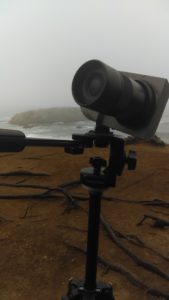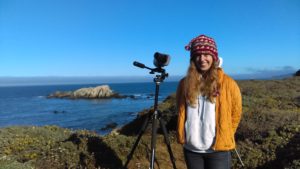Hi All,
Today is my last day collecting data at Sea Ranch–the weather is very foggy and a little bit rainy. I think Seattle might be sending its weather down here, telling me it’s time to head home. Here is a photo from this morning at GPI N that shows the fog and the difficulties it creates in collecting data!
The breeding season here at Sea Ranch has been a little unusual this year, especially at GPI. Overall, there were a total of 38 nests at GPI N and 41 nests at GPI S. Unfortunately, we did not see any WEGU chicks from any nests reach the juvenile stage of development. About half of the WEGU nests hatched chicks and half were abandoned before any chicks were seen. We suspect that a Peregrine falcon may be the cause of this abnormal number of chicks, as one morning, a group at GPI S witnessed the falcon swooping low over the gulls and snatching up a chick! Following that incident, we often saw a Peregrine falcon perched on the far north end of GPI, spying on potential prey.
The Pelagic cormorants at Breakers Reach had a better year than the WEGUs at GPI, with about a 50% success rate in the number of nests that hatched chicks. Of 28 nests, so far 14 nests have hatched eggs, 13 nests have been abandoned, and one is still sitting on a nest with three eggs. Overall, it seems like once Pelagic chicks hatch, they make it to adulthood. Only one nest had a chick that disappeared after a few days and the nest was abandoned shortly afterwards.
Thank you to everyone who played such an important role in this summer’s adventures! This was an incredible experience that taught me so much about long term ecological studies, dedicated observation skills, and asking thoughtful questions that may not have a clear answer. It was wonderful meeting many Sea Ranch locals and visitors and getting to share what we have been working on these past three years (at Pomona) and past several years (with the Sea Ranch Task Force).
For now, goodbye Sea Ranch, I hope to see you again!
-Ellie


